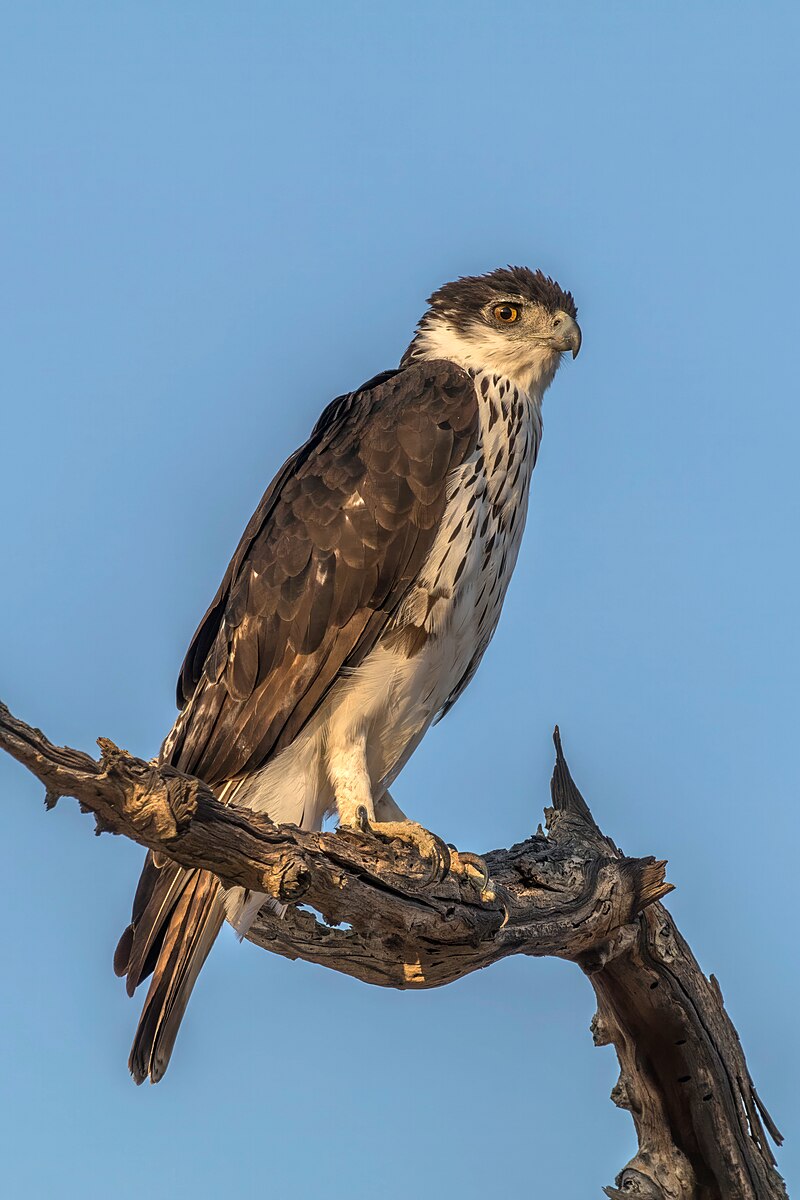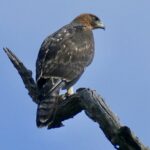The African hawk eagle, also known as the crowned eagle, is a large bird of prey found in sub-Saharan Africa. It is considered to be the most powerful raptor in Africa, even more so than the martial eagle and the Verreaux’s eagle. The crowned eagle is the only extant member of the genus Stephanoaetus coronatus, with a second species, the Malagasy crowned eagle, having gone extinct after early humans settled on Madagascar.
Hunting Capabilities of the African Hawk Eagle
The crowned eagle is a specialized primate hunter, with at least 90 percent of its diet consisting of mammals, primarily small ungulates such as dik-dik, duikers, chevrotains, suni, and Royal antelope, as well as young gazelles, meerkats, mongooses, mustelids, rats, rock hyraxes, and primates such as young or smaller baboons, bushbabies, colobus, mangabeys, or vervet monkeys. The eagle’s long tail imparts an overall length of up to 90 cm (35 in), but it is lighter by weight and has a considerably shorter wingspan than Africa’s largest eagle, the martial eagle.
The crowned eagle possesses unusually large talons and strong legs, and may kill by simply crushing prey’s skull. It is also bold and ferocious, with records showing the remains of a large male sooty mangabey weighing 11 kg (24 lb) beneath a nest. The eagle’s power has been estimated from the size of its feet and talons and from the prey it typically selects, as there are no known actual tests in any African raptor of the pressure exerted via their grip.
Interactions with Humans
 Image source: African hawk-eagle by Charles J. Sharp
Image source: African hawk-eagle by Charles J. Sharp
While several smaller raptorial birds will attack humans if they come too close to their nests, there are no known cases of the crowned eagle attacking humans in the wild. However, there have been reports of crowned eagles taking human children, although these incidents are extremely rare and may be due to predatory intent or defensive behavior. The most definitive reported case is described in Peter Steyn’s “Birds of Prey of Southern Africa: their identification and life histories,” in which a seven-year-old boy was attacked and “savagely clawed” on the head, arms, and chest by an immature crowned eagle. The eagle did not survive, but the boy was successfully treated at a nearby mission hospital.
Comparison of Strength and Capabilities
To better understand the capabilities of the African hawk eagle compared to humans, let’s look at some key data points:
| Characteristic | African Hawk Eagle | Human |
|---|---|---|
| Weight | 3.2 – 6.2 kg (7 – 14 lbs) | 62 – 98 kg (137 – 216 lbs) |
| Wingspan | 1.6 – 2 m (5.2 – 6.6 ft) | 1.5 – 2 m (4.9 – 6.6 ft) |
| Talons | Extremely large and powerful | Relatively small and weak |
| Prey Hunting | Specializes in hunting primates and small mammals | Omnivorous, primarily hunts with tools and weapons |
| Aggression | Bold and ferocious, can kill prey by crushing skull | Generally less aggressive, relies on tools and cooperation |
As the data shows, the African hawk eagle is a formidable predator with impressive physical capabilities, including large talons, strong legs, and a specialized hunting strategy targeting primates and small mammals. In contrast, humans rely more on tools, weapons, and cooperation to hunt and defend themselves.
While there have been rare incidents of crowned eagles attacking human children, these cases are extremely uncommon, and the eagle does not pose a significant threat to adult humans in the wild. The eagle’s dietary preferences and hunting strategies are primarily focused on smaller mammalian prey, and there is no evidence to suggest that it actively hunts or targets humans as a primary food source.
Conclusion
In conclusion, the African hawk eagle is a powerful and impressive bird of prey, but it does not pose a significant threat to adult humans in the wild. Its hunting capabilities are primarily focused on smaller mammalian prey, and while it may occasionally attack human children, these incidents are extremely rare. Humans, on the other hand, have developed sophisticated tools, weapons, and cooperative strategies to hunt and defend themselves, making them less vulnerable to predation by the crowned eagle.
References:
– https://www.youtube.com/watch?v=uv8KPtMSI3U
– https://www.australiangeographic.com.au/topics/wildlife/2017/11/can-eagles-eat-babies/
– https://en.wikipedia.org/wiki/Crowned_eagle
– https://www.youtube.com/watch?v=XsB-wC24XGc
– https://lithub.com/this-eagle-would-eat-your-toddler-if-it-had-the-chance/


